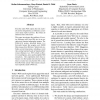EMNLP
2010
13 years 10 months ago
2010
EMNLP
2010
13 years 10 months ago
2010
Word alignment plays a central role in statistical MT (SMT) since almost all SMT systems extract translation rules from word aligned parallel training data. While most SMT systems...
EMNLP
2010
13 years 10 months ago
2010
With the proliferation of user-generated articles over the web, it becomes imperative to develop automated methods that are aware of the ideological-bias implicit in a document co...
EMNLP
2010
13 years 10 months ago
2010
Extant Statistical Machine Translation (SMT) systems are very complex softwares, which embed multiple layers of heuristics and embark very large numbers of numerical parameters. A...
EMNLP
2010
13 years 10 months ago
2010
The task of selecting information and rendering it appropriately appears in multiple contexts in summarization. In this paper we present a model that simultaneously optimizes sele...
EMNLP
2010
13 years 10 months ago
2010
We present an approach to grammar induction that utilizes syntactic universals to improve dependency parsing across a range of languages. Our method uses a single set of manually-...
EMNLP
2010
13 years 10 months ago
2010
Even the entire Web corpus does not explicitly answer all questions, yet inference can uncover many implicit answers. But where do inference rules come from? This paper investigat...
EMNLP
2010
13 years 10 months ago
2010
We present a simple, robust generation system which performs content selection and surface realization in a unified, domain-independent framework. In our approach, we break up the...
EMNLP
2010
13 years 10 months ago
2010
Polysemy is a major characteristic of natural languages. Like words, syntactic forms can have several meanings. Understanding the correct meaning of a syntactic form is of great i...
EMNLP
2010
13 years 10 months ago
2010
In many NLP systems, there is a unidirectional flow of information in which a parser supplies input to a semantic role labeler. In this paper, we build a system that allows inform...




